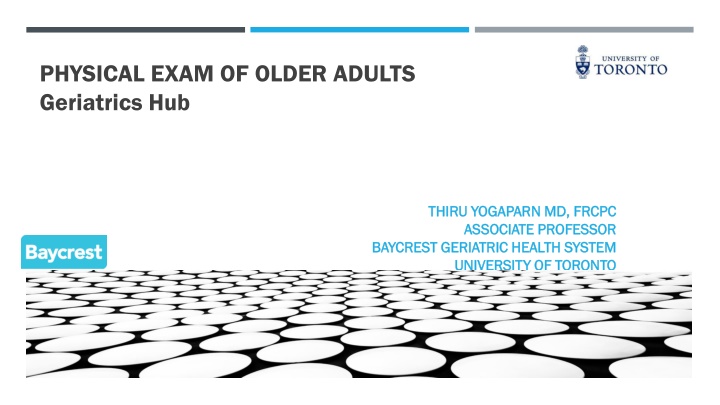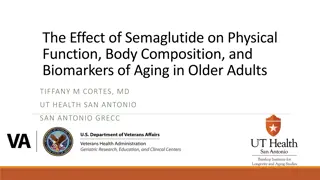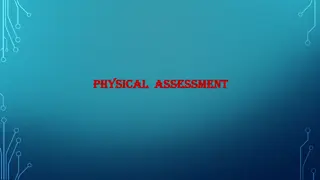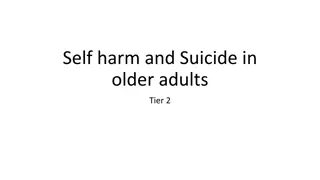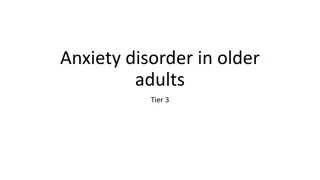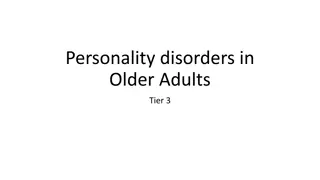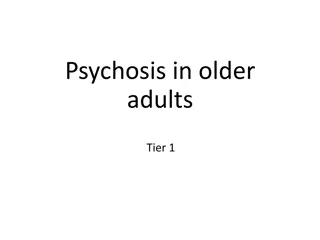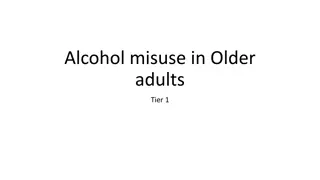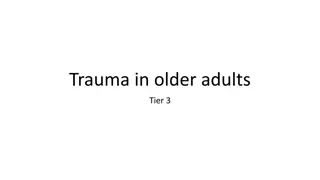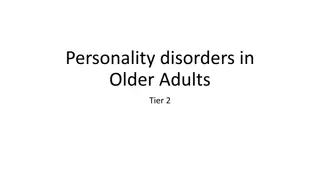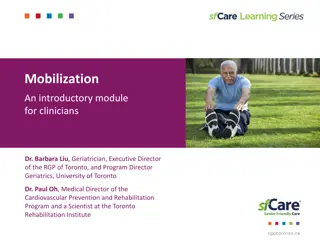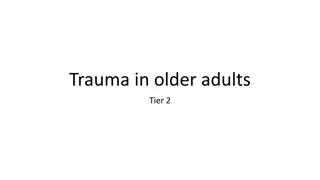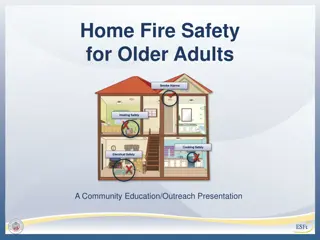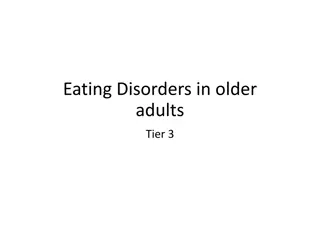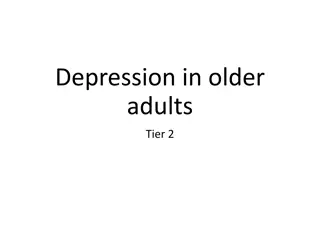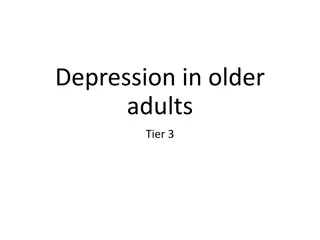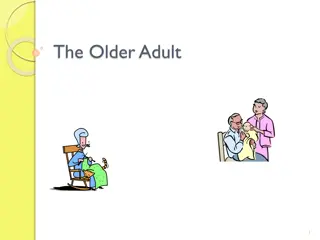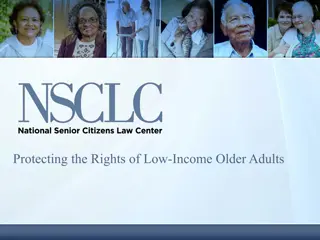Comprehensive Physical Examination of Older Adults in Geriatrics
This resource provides valuable insights into the physical examination of older adults in geriatrics, emphasizing important considerations, differences from young adult exams, interpreting findings, and observing general appearance and mental status for clues regarding cognitive and functional abilities. It covers special attention areas like cognitive function, mobility, and continence, offering guidance on organizing the exam efficiently for patient comfort and thorough assessment of age-related and disease-related changes.
Download Presentation

Please find below an Image/Link to download the presentation.
The content on the website is provided AS IS for your information and personal use only. It may not be sold, licensed, or shared on other websites without obtaining consent from the author.If you encounter any issues during the download, it is possible that the publisher has removed the file from their server.
You are allowed to download the files provided on this website for personal or commercial use, subject to the condition that they are used lawfully. All files are the property of their respective owners.
The content on the website is provided AS IS for your information and personal use only. It may not be sold, licensed, or shared on other websites without obtaining consent from the author.
E N D
Presentation Transcript
PHYSICAL EXAM OF OLDER ADULTS Geriatrics Hub THIRU THIRU YOGAPARN YOGAPARN MD, FRCPC ASSOCIATE PROFESSOR ASSOCIATE PROFESSOR BAYCREST GERIATRIC HEALTH SYSTEM BAYCREST GERIATRIC HEALTH SYSTEM UNIVERSITY OF TORONTO UNIVERSITY OF TORONTO MD, FRCPC
GOALS AND OBJECTIVES At the end of session, learner will be able to Describe the differences between young adult physical exam and older adult physical exam Interpret physical findings in older patient, differentiating age related changes and disease related changes
PHYSICAL EXAM : IMPORTANT THINGS TO CONSIDER General principles same as young adults Special attention is paid to problems that interfere with function, Such as cognitive function, mobility, continence, hearing and visual impairment. No perfect order Pay attention to patient comfort Do not shift the patient several times Organize your physical exam in a way that you change the position only once , E.g. I keep the postural BP for the end Have more time, as frail older patient may take longer time to get dressed and undressed, or move from chair to table
PHYSICAL EXAM : IMPORTANT THINGS TO CONSIDER Observing patients while they are walking into the examination room, sitting in or rising from a chair, getting on and off an examination table, ability to stand on a weighing scale, taking off or putting on cloths, exam gown ,socks and shoes can provide valuable information about their function The extent and type of help they need for these will give you clues e.g. needs assistance for transfers, needs cueing for dressing etc. Can gauge their balance, judgment and cognitive function Considering the atypical presentation of illness in older adults, often patients require full physical exam On the same token, in frail older adults with acute illness, presence of physical exam findings are useful, but absence of typical physical exam findings do not rule out illness
GENERAL APPEARANCE Vitality Appearance e.g. young looking or older looking Hygiene Grooming Indicators for clinical problem e.g. strong smell of urine General appearance can give clues to the patient s cognitive status and functional ability E.g. dirty clothing may indicate dementia, depression, visual impairment or functional decline Inappropriate foot wear may be the reason for falls Indicators for frailty
MENTAL STATUS General principles not different from young but you will assess their mood, cognition further depending on the nature of assessment Tools to screen cognition e.g. : Minicog MMSE MoCA RUDAS Tools to screen mood e.g. : Patient Health Questionnaire-2 (PHQ-2) Geriatric depression scale
WEIGHT HEIGHT AND VITAL SIGNS Weight is very important in older adults Series of weights will help BMI- desired ranges same as younger population Waist: hip ratio and waist circumference, better indicator than BMI Height: Older people loose height due to thinning of the inter vertebral discs and osteoporosis
VITAL SIGNS The normal ranges for BP, HR, temp, RR patients However there are important changes in BP, HR, temp and RR with normal ageing Do not change Do not change for geriatric
TEMPERATURE Temperature in the older patient may be on the lower end of the normal range due to decrease in metabolic rate, loss of muscle mass, and other factors Older patients are less able to raise their temperature (have a fever) due to impaired thermoregulation when they do become ill Always check the baseline temp and change in temp in frail old patients e.g. nursing home patient A temp of 37.5 may indicate a serious illness in a frail patient Bottom line is when they have a fever take it seriously, but absence of fever does not exclude an infection
PULSE Resting heart rate stays the same Maximum heart rate (e.g., with exercise) goes down with age, A rough formula for this is Males: Maximum HR =220-age Females: Maximum HR =(220-age ) x 0.85 Premature atrial and ventricular beats are very common with aging and can make it seem like the patient has an irregular rhythm when you take their pulse Atrial fibrillation is also common with ageing Absent peripheral pulses need further investigations If you suspect temporal arteritis from the history look for absent temporal artery pulses and tenderness Brisk carotid artery upstroke (May mask aortic stenosis)
BLOOD PRESSURE Due to stiffening of the arteries there is a tendency for the systolic blood pressure to rise with aging with less rise in the diastolic blood pressure Pulse pressure (systolic - diastolic) widens About 11-28 % of patients >65 years have orthostatic hypotension (a drop in blood pressure with standing of more than 20mmHg systolic or 10mmHg diastolic). Always check BP in both arms on the first visit, as they may have silent PVD
RESPIRATORY RATE AND PULSE OXIMETRY Resting respiratory rate is generally unchanged with normal aging Tachypnea at RR. >24/minute is very reliable sign for lower respiratory tract infection even in very old patients The normal older adult patient will often have a pulse oximetry reading which is lower by a few percentage points. very reliable sign
VISION AND HEARING SCREENING A pocket Snellen chart held 14 in from eyes Whisper test or audio scope
AUDIOSCOPE AND WHISPER TEST Conducting the whispered voice test15 17 The examiner stands arm s length (0.6 m) behind the seated patient and whispers a combination of numbers and letters (for example, 4-K-2) and then asks the patient to repeat the sequence The examiner should quietly exhale before whispering to ensure as quiet a voice as possible If the patient responds correctly, hearing is considered normal; if the patient responds incorrectly, the test is repeated using a different number/letter combination The patient is considered to have passed the screening test if they repeat at least three out of a possible six numbers or letters correctly The examiner always stands behind the patient to prevent lip reading Each ear is tested individually, starting with the ear with better hearing, and during testing the non-test ear is masked by gently occluding the auditory canal with a finger and rubbing the tragus in a circular motion The other ear is assessed similarly with a different combination of numbers and letters BMJ.COM 2003;327:967
HEENT EXAM Head Exam Head Exam Fat pads around the eyes can atrophy : It may cause gradual sinking of the eye backward into the orbit (enophthalmos). Thus, enophthalmos is not dehydration in older adults. Eyelid skin can become loose and hang in folds, occasionally obstructing vision (senile ptosis) not necessarily a sign of
HEENT EXAM Eyes: Presbyopia (eye's inability to focus on close objects) occurs due to loss of elasticity of the lens and is considered a part of normal aging Arcus senilis - a grayish-white ring at the edge of the cornea frequently in older patients Look for opacities of the lens on exam as cataracts are common Unequal pupil size may be from previous cataract surgery The eye examination should focus on testing visual acuity (e.g. using a Snellen chart). Visual fields can be tested at the bedside by confrontation Ophthalmoscopy- the retina s appearance usually does not change much with aging. Look for cataracts, optic nerve or macular degeneration, and evidence of glaucoma, hypertension, or diabetes. Annual eye exam by an optometrist or ophthalmologist is recommended after age 50
HEENT EXAM Ears: Be sure to examine the ears for impacted ear wax (cerumen) which is common Neck Exam: Lymph nodes tend to atrophy and may be harder to feel or absent on cervical exam Submandibular glands are easily felt Bottom line Bottom line if you feel LN anywhere take it seriously
ORAL EXAM Examine for- tooth and gum health, denture sores and oral cancer look for bleeding or swollen gums, loose or broken teeth, fungal infections, and signs of cancer (e.g., leukoplakia, erythroplakia, ulceration, mass). Tooth loss is not a normal part of aging, but is frequent due to cumulative effects of dental caries and periodontal disease 1/3 of geriatric patients have lost all their teeth, >1/2 wear dentures Remember to remove the dentures - key to a thorough oral exam Oral cancers are common in older patient with long standing ETOH or tobacco use or poor oral hygiene Remember poor dentition can affect nutrition
CARDIOVASCULAR EXAM Inspection Inspection Increased tortuosity, uncoiling, and lengthening of the aorta with age can result in the carotid artery buckling or kinking in the neck on the right and appear as a pulsating mass. Palpation Palpation Apical cardiac impulse may be difficult to palpate due to chest wall changes Auscultation Auscultation Due to arthrosclerosis, you may hear bruits over the carotids. Premature atrial and ventricular beats are very common with aging and can make it seem like the patient has an irregular rhythm when you listen to their heart AF is also common- irregular HR
CARDIOVASCULAR EXAM Auscultation Auscultation S3 can be normal in younger patients, but after the age of 40 it is almost always pathologic (e.g., congestive heart failure). An S4 is heard more frequently in older patients due to the stiffening of the ventricles > 1/2 of patients over the age of 85 will have a systolic murmur heard at the right upper sternal border from aortic valve sclerosis which occurs as the aortic valve cusps thicken and become fibrotic with normal aging Valvular heart disease is more prevalent than younger population, so listen carefully for murmurs
PULMONARY AND THORAX EXAM Not many differences in the exam compared to young patients Kyphosis (increased curving of the thoracic spine) Barrel chest- the anterior posterior diameter of the chest increases (has no functional significance) The chest wall becomes stiffer, and the diaphragm s strength is reduced by about 25% in older adults Less effective cough
ABDOMINAL EXAMINATION There is a tendency for fat to accumulate or redistribute to the lower abdomen and hips, producing a potbelly In frail old patients with acute abdomen - the signs of peritonitis (e.g. guarding, rebound) can be diminished or even absent During auscultation, listen for abdominal bruits (from atherosclerosis) Palpate for a widened aorta as can been seen with abdominal aortic aneurysms, more common with age Unsuspected fecal impaction is common May find distended urinary bladder Pay attention to the scars
NEUROLOGICAL EXAM Sensation: decreased smell and taste normal Frequently, you will find diminishing or a loss of vibration sense in the feet/ankles Peripheral neuropathy is common in older patients Reflexes: Ankle reflex can be diminished or absent Gag reflex may also be diminished or absent Primitive reflexes, such as grasp and snout reflexes can return and can be of no consequence Focal signs need further further assessment Remember to do vision and hearing screening Gait most important part of neuro exam
GAIT AND MOBILITY Very important and useful, can be observed while they come in Gait speed is a simple, important clinical marker of current health and well-being and is a powerful predictor of mortality in older adults Gait speed, chair rise time, and the ability to do tandem stance are independent predictors of the ability to do instrumental activities of daily living and of the risk of nursing home admission and death. https://www.merckmanuals.com/profes sional/geriatrics/gait-disorders-in-older- adults/gait-disorders-in-older-adults As such, gait speed has been proposed as a vital sign of overall health and well-being. Gait speed changes with aging; Previous studies have reported that gait speed is relatively stable up to age 65, Declines 1% per year from age 65 to 69, and Further declines to 4% per year for adults older than 80 years Substantial variation in the rate of decline across individuals. Gait speed is very useful in identifying frailty, and also helps to predict cognitive impairment There is a non-linear relation between gait speed and falls with a greater risk of outdoor falls in faster walkers and greater risk of indoor falls in slow walkers. Get up and Go test is a simple useful test
GAIT A performance-based evaluation of Gait Symptom Potential cause Potential cause Difficulty rising from a chair Lower limb weakness Osteoarthritis Instability on first standing Postural hypotension Muscle weakness Instability with eyes closed Proprioception deficits Decreased step height/length Parkinsonism Frontal lobe disease Fear of falling MONTERO-ODASSO, M., & MASUD, T. (2020). FALLS AND GAIT DISORDERS IN OLDER ADULTS: CAUSES AND CONSEQUENCES. IN FRAILTY AND KIDNEY DISEASE
MUSCULOSKELETAL EXAMINATION Range of Motion: Range of motion of the joints decreases, mainly due to osteoarthritis (Muscle Bulk/Strength: Muscle decreases in bulk, and there is mildly diminished strength. Due to muscle bulk decline, the joints might look very prominent. Hands may look thin/bony due to atrophy of the interosseus muscles
FOOT EXAM Foot disorders in older adults are associated with falls and reduced mobility which can lead to functional decline and frailty On the other hand suboptimal foot hygiene may be an indicator of functional decline. Foot examination is an important component of the comprehensive assessment of an older adult and a falls assessment Age-related changes in foot muscle, joints, soft tissue, and posture can impair mobility Loss of elastin and collagen fibers contribute to changes in the aging foot and can cause hard, dry skin on the plantar surface hyperkeratosis is common in older adults. Common age-related findings include hallux valgus, medial prominence of the 1st metatarsal head with lateral deviation and rotation of the big toe, and lateral deviation of the 5th metatarsal head. Hammer toe (hyperflexion of the proximal interphalangeal joint) and claw toe (hyperflexion of the proximal and distal interphalangeal toe joints). Toe deformities may result from years of wearing poorly fitting shoes or from medical conditions such as arthritis, sensory neuropathy .
FOOT PHYSICAL EXAM Can they remove and replace shoes and socks without assistance? What type of shoes are they wearing (e.g., slip on, laces, Velcro)? How worn is the footwear? Is it appropriate for the season? Is it safe ? Are they wearing socks? Footwear: I had clinic patient with his son, both insisting he was functioning very well in spite of his cognitive deficits. When I removed his socks it was obvious that patient has not cleaned his feet for months, which was shocking to his son. Skin Hygiene (particularly dirt and moisture between toes) Dryness, Hyperkeratosis (calluses and corns) Fissures Ulcers inspection : Length Thickening Ingrown/broken Fungal infection Nail inspection: In this case foot inspection, helped to convince the son about the functional decline and diagnosis of dementia! Bony deformity Hallux valgus, Hammer/overlapping toes Foot pain/tenderness Reduced range of motion Pes planus (flat foot) Examination of the foot: Is temperature equal in both feet? Is there an absence or reduction of hair growth? Is there edema present? Check pedal pulses Is light touch sensation intact (Ipswich touch test)? A vascular and neurological assessment: Adopted from Table3, James K, Orkaby AR, Schwartz AW. Foot Examination for Older Adults. Am J Med. 2021 Jan;134(1):30-35. doi: 10.1016/ Adopted from Table3
SKIN Aging: more changes in skin & hair. Normal aging + the cumulative effects from exposure to the sun, Skin wrinkles, looses elasticity, and thins Scalp hair loses its pigment causing graying and also thins Hair loss occurs throughout the body (pubic, axillae, limbs). You can see numerous types of skin changes more frequently with age, for example Cherry angioma liver spots or age spots (solar lentigos) in sun exposed areas, Seborrheic keratoses
MALE Genital Examination: Pubic hair decreases The penis can decrease in size The testicles can drop lower in the scrotum and mild atrophy is common Inability to have an erection is a problem for up to half of all older men Rectal Examination: Examination of the prostate on rectal exam is an important part of the older male exam
FEMALE Breast Exam: With aging, the glandular tissue in the female breast is replaced by fat; breasts also atrophy and become more pendulous It can be easier to pick up a breast mass in an older women Ducts around the nipple can become palpable (feel like strings)
PELVIC EXAM There is decrease in pubic hair, vaginal narrowing/ shortening, and vaginal mucosal thinning and drying due to loss of vaginal lubrication Ovaries are usually non-palpable by about 10 years after menopause Pelvic organ prolapse is very common finding on physical exam and can be a contributor to urinary symptoms Important to examine examine for UV prolapse, cystocele, rectocele in a patient with urinary incontinence urinary incontinence lithotomy position may not be comfortable if they have severe arthritis
GERIATRIC FUNCTIONAL ASSESSMENT PHYSICAL EXAM Visual screen with the use of hand held Jaeger eye charts Auditory screen with the whisper test or handheld audio scope Screening for shoulder, arm and hand mobility. Ask the patient to lift both arms, touch the opposite shoulder, and put their arms behind them as if putting on a bra. Then ask them to pick up a small object, such as a pen or a penny, from a flat surface. Cognitive assessment If you suspect depression you could administer the Geriatric Depression Scale Gait assessment including rising from a chair, walking, turning around and sitting down again
REF Bickley, Lynn S. (2003). Bates' guide to physical examination and history taking. Philadelphia :Lippincott Williams & Wilkins, Skrastins R, Merry GM, Rosenberg GM, Schuman JE. Clinical assessment of the elderly patient. Can Med Assoc J. 1982 Aug 1;127(3):203-6. PMID: 7104901; PMCID: PMC1861935. Montero-Odasso, M., & Masud, T. (2020). Falls and Gait Disorders in Older Adults: Causes and Consequences. In Frailty and Kidney Disease (pp. 13 35). Springer International Publishing. https://doi.org/10.1007/978-3-030-53529-2_3 Rodriguez, V., & Bakar, M. (2019). Normal Versus Abnormal Physical Exam. In Geriatric Practice (pp. 49 66). Springer International Publishing. https://doi.org/10.1007/978-3-030-19625-7_5 https://www.merckmanuals.com/professional/geriatrics/approach-to-the-geriatric-patient/evaluation-of-the-older-adult Cesari M, Kritchevsky SB, Penninx BW, et al. Prognostic value of usual gait speed in well-functioning older people results from the Health, Aging and Body Composition Study. J Am Geriatr Soc.2005;53:1675 1680. Studenski S, Perera S, Patel K, et al. Gait speed and survival in older adults. JAMA. 2011;305:50 58 Quach L, Galica AM, Jones RN, et al. The nonlinear relationship between gait speed and falls: the Maintenance of Balance, Independent Living, Intellect, and Zest in the Elderly of Boston Study. J Am Geriatr Soc. 2011;59(6):1069-1073. doi:10.1111/j.1532-5415.2011.03408.x James K, Orkaby AR, Schwartz AW. Foot Examination for Older Adults. Am J Med. 2021 Jan;134(1):30-35. doi: 10.1016/j.amjmed.2020.07.010. Epub 2020 Aug 14. PMID: 32805226
